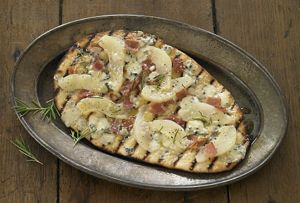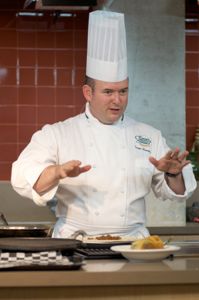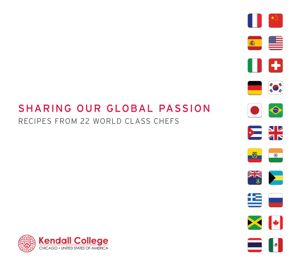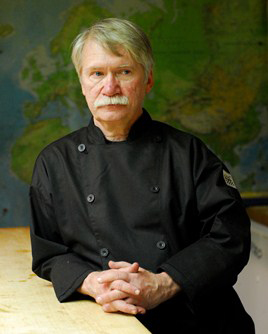Why Focus on Flatbreads?
Thursday, 01 May 2014 03:00
 Though not new to the market by any stretch, flatbreads, particularly those that say “global,” are enjoying a revolution. A pastry chef-instructor at Kendall College in Chicago reports on the trend, making the case for need-to-know among culinary-arts and pastry/baking students as they embark on their careers.
Though not new to the market by any stretch, flatbreads, particularly those that say “global,” are enjoying a revolution. A pastry chef-instructor at Kendall College in Chicago reports on the trend, making the case for need-to-know among culinary-arts and pastry/baking students as they embark on their careers.
By Heidi Hedeker, CMB, MA/MSW
In the realm of baked goods, flatbreads don’t have a standard definition. Wheat flour is often the main ingredient, and just as often not. Flatbreads are leavened or unleavened. No nation on earth can claim to be the origin of flatbread (although the region that includes modern-day Iraq can take some credit), and no single flavor, color or texture is shared by all flatbreads. Some breads considered flatbreads aren’t even particularly flat. Or thin.
When you think of the lifestyle trends of the last several years, today we are basically nomads. More of the foods we eat are to go, and what is more nomadic than a flatbread? The origins of most of today’s flatbreads are in early agrarian society. Foods had to be simple enough for travel. That fits with our lifestyle today, because everything we do is portable.

 The chancellor of Johnson & Wales University tells chefs to follow their passion to achieve success while also becoming agents of change in their industry and careers.
The chancellor of Johnson & Wales University tells chefs to follow their passion to achieve success while also becoming agents of change in their industry and careers. For those visiting Chicago for this year’s National Restaurant Association Restaurant, Hotel-Motel Show, mouths water and palates yearn for one of the City of Big Shoulders’ culinary claims to fame. And among pies, four take the cake.
For those visiting Chicago for this year’s National Restaurant Association Restaurant, Hotel-Motel Show, mouths water and palates yearn for one of the City of Big Shoulders’ culinary claims to fame. And among pies, four take the cake. The challenge of college includes managing multiple demands and a complex schedule, often for the first time as an adult. Something as simple as taking attendance in class can motivate students to not only stay in the course and program, but thrive.
The challenge of college includes managing multiple demands and a complex schedule, often for the first time as an adult. Something as simple as taking attendance in class can motivate students to not only stay in the course and program, but thrive. A group of students from The Culinary Institute of America (CIA) campus in Hyde Park, N.Y., is spending the first semester of senior year at the college’s campus in San Antonio, Texas, focusing on the ingredients, techniques and cultural traditions of Latin American cuisines. It is part of the CIA’s Latin Cuisines Concentration, which launched May 5—Cinco de Mayo.
A group of students from The Culinary Institute of America (CIA) campus in Hyde Park, N.Y., is spending the first semester of senior year at the college’s campus in San Antonio, Texas, focusing on the ingredients, techniques and cultural traditions of Latin American cuisines. It is part of the CIA’s Latin Cuisines Concentration, which launched May 5—Cinco de Mayo. The Baker College of Port Huron student-operated, fine-dining restaurant and bar at the Culinary Institute of Michigan (CIM) has opened its doors, serving up Michigan products and beautiful local views. The CIM Port Huron is located at 2000 St. Clair Street, Port Huron.
The Baker College of Port Huron student-operated, fine-dining restaurant and bar at the Culinary Institute of Michigan (CIM) has opened its doors, serving up Michigan products and beautiful local views. The CIM Port Huron is located at 2000 St. Clair Street, Port Huron. Kendall College is proud to announce the release of its first culinary publication, Sharing Our Global Passion: Recipes from 22 World Class Chefs ($25), a compilation of recipes that reflect the backgrounds, professional training and world experiences of faculty in the School of Culinary Arts. Published by the preeminent culinary-arts educational experience in the Midwest, this book celebrates the diversity of global cuisine in both classic style and modern interpretation.
Kendall College is proud to announce the release of its first culinary publication, Sharing Our Global Passion: Recipes from 22 World Class Chefs ($25), a compilation of recipes that reflect the backgrounds, professional training and world experiences of faculty in the School of Culinary Arts. Published by the preeminent culinary-arts educational experience in the Midwest, this book celebrates the diversity of global cuisine in both classic style and modern interpretation. Courtesy of Mercer Cutlery
Courtesy of Mercer Cutlery As culinary educators we have a unique opportunity to view student assessment differently—in a way that measures the ability to “demonstrate understanding” vs. the ability to memorize.
As culinary educators we have a unique opportunity to view student assessment differently—in a way that measures the ability to “demonstrate understanding” vs. the ability to memorize.